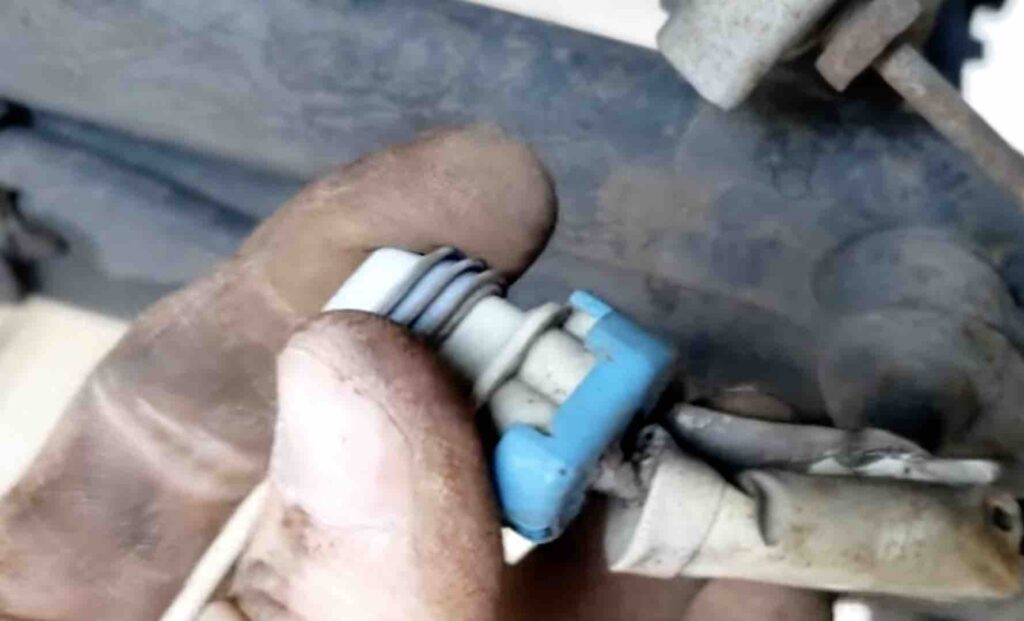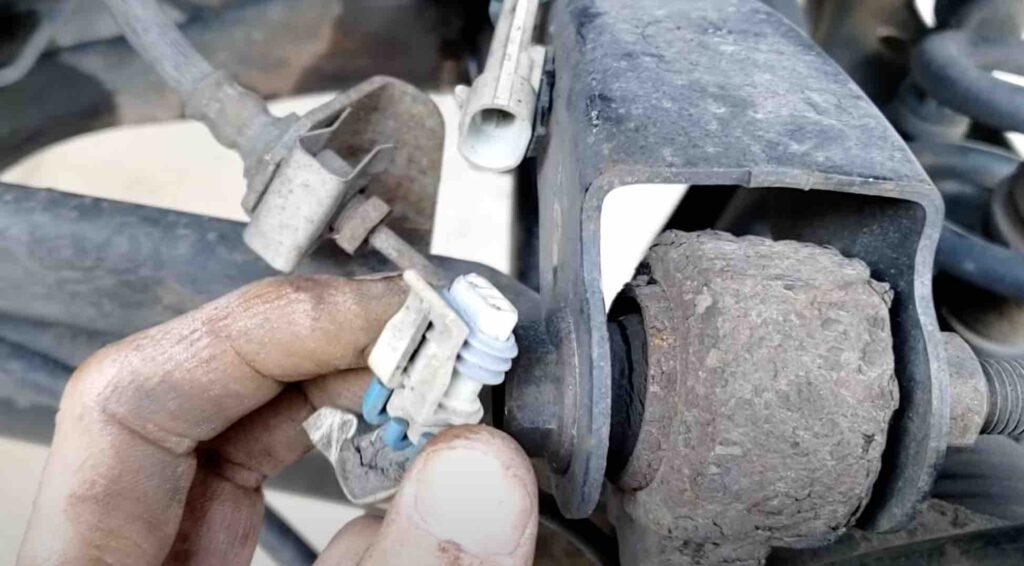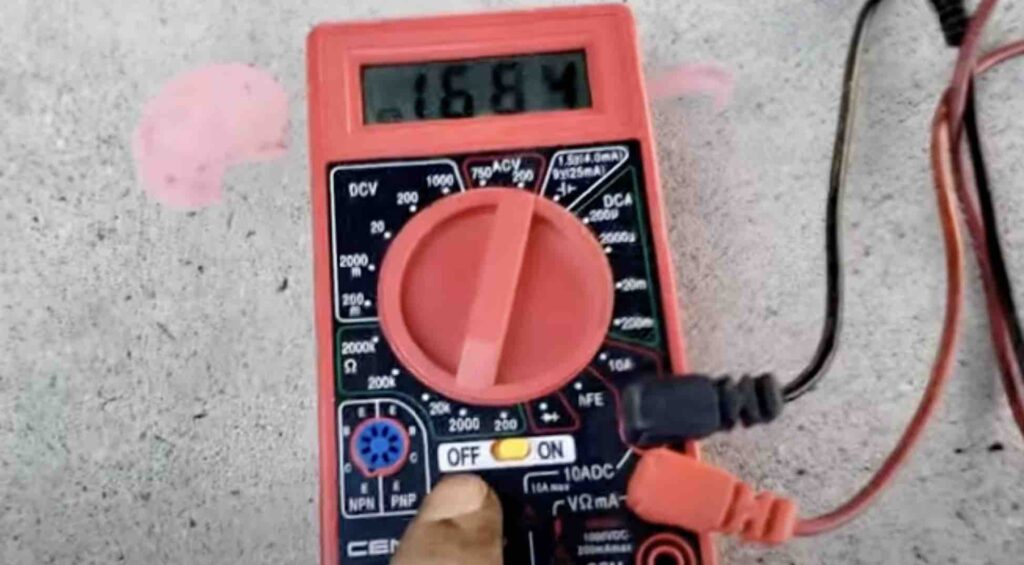Last updated on November 15th, 2022 at 08:55 am
How to test a abs sensor with a multimeter? If you have pondered on the question, what causes wheel speed sensor failure? “Can Abs Sensor Cause Transmission Problems?” or how to fix ABS sensor problems, then you are on the right path reading this article. Although, the failure or malfunction of any vehicle component will possibly affect the entire system and could cause severe issues in the system. Significantly, the ABs are one of the most vital brake-system of automobiles.
The ABs are in the brake assembly monitor and measure the wheel’s rotational speed as it transmits information to the ECM before relaying it to the Hydraulic Control Unit. However, most vehicles have one sensor per wheel as an anti-skid, not for the car’s traction.
If the ABs sensors become faulty, the entire braking system (the 4 wheels) will also fail. Similarly, when ABs are faulty, you will see an ABs sensor warning light on the dashboard of your vehicle. This notification indicates that something has gone wrong with one of the sensors.
Nevertheless, this article will raise the standard of your knowledge about the following content such as; what can a faulty abs sensor cause, can abs sensor cause transmission problems, how to fix ABs sensor, ABs sensor location, ABs sensor price, can a bad ABs sensor cause vibration, what causes wheel speed sensor failure, how to tell which abs sensor is bad without a scanner and many more.
Let’s get started immediately! Related article Service StabiliTrak Light Meaning, Symptoms, Fix and Reset Guide

What Can A Faulty Abs Sensor Cause?
A faulty Abs sensor can cause the following
- Loss of stability while the is accelerating.
- The improper shift of the transmission.
- TCN or Abs light to come.
- Skidding while braking.
Can Abs Sensor Cause Transmission Problems?
In essence, there is a link between the Abs and the gearbox; if the Abs are bad, the gearbox will be affected. The wheel speed sensors perform to keep a tab on the wheel speed and relay the information to the Abs in all vehicles.
Similarly, the Abs transmit data to the traction control as the ECU controls their functions. In essence, the Abs control and handles the restoration of information from the vehicle’s ECU, which initiates the speed information in certain situations.
So, suppose Abs sensors can deliver inaccurate data to the ECU when malfunctioning. In that case, your transmission system might receive incorrect signals as to the defect of the sensors, thereby causing transmission problems.
Abs sensors are vital but prone to transmission issues; you should take your vehicle to a professional if the Abs warning comes on your dashboard. However, this warning light could be a troubleshoot, and you should use a multimeter to diagnose the ABS troubleshooting.
Abs Sensor Location
The location of the Abs sensor is on the inner side of the wheel hub as it mounts on the axle or knuckle in various vehicles. The Abs sensor can be accessed or found when you lift the wheel of your car or turn your tire in one direction,

How To Fix Abs Sensor
It is very vital to remove/fix/repair the Abs sensor if it is lousy or faulty, and doing that requires the following procedures below;
Removal Of Bad Abs Sensor
- Lift the vehicle using a jack as you remove the wheels for easy access to the wheel hub
- Loosen the lug nuts from your tire and remove the vehicle’s wheel with a wrench.
- Access the sensor as you locate it along the body of the wheel hub.
- Loosen the bolt holding the Abs sensor as you dismount the sensor with an Allen wrench.
- Using a pair of pliers, wiggle the sensor as you
- Remove any dirt from the sensor lodge as you blow canned air into its lodge, or use a wire brush gently to remove rust.
Installing A New Abs Sensor
- Push a new sensor into the lodge as you securely position it.
- Connect the wirings to the new sensor.
- Replace and twist the bolt as you securely set the sensor using a wrench.
- Reposition the wheels and make sure you screw the lug nuts back into place.
- You should repeat the process on each wheel until the Abs warning light stops.
Abs Sensor Price
Each sensor costs between $200 to $400 in any auto parts shop, whereas your mechanic or technician could charge you about $150 to $200 for the labor since it is time-consuming. Perchance, the Abs sensors should be replaced every 30,000 to 50,000 miles.
Although you are knowledgeable and have much experience, you could do it yourself. Be sure to use the manufacturer’s guide!
Can A Bad Abs Sensor Cause Vibration?
Of course, yes! A bad Abs sensor can cause vibration. If the Abs fails, an Abs warning light will appear on the dashboard, and if this stays as the vehicle is started.
The vehicle’s speed and acceleration will drop very low since the Abs function monitors and measure the vehicle’s speed and relate the information to the computer, ECU.
A bad Abs will define the vehicle’s acceleration once it has failed and caused it to vibrate. So, you can install a new Abs sensor; the Powertrain Control Module (PCM) will reset itself. You can use the scan tool to retrieve the PCM’s memory for proper diagnoses.
What Causes Wheel Speed Sensor Failure?
Although, so many damages occur to the hub or wheel bearing composing the internal wheel speed sensor and external sensors in your vehicle.
However, the causes of the wheel speed sensor failure are as follows;
- Particles of metallic debris are attached to the magnetic encoder ring of your wheel speed sensor.
- Corrosion weakens the sensor’s signal strength due to air gap spacing.
- Excessive bearing end play in your wheel bearing.
- A mechanical problem arises from the inability of the sensors to render due to road debris.
How To Tell Which Abs Sensor Is Bad Without Scanner
Indeed, the fastest way to tell which Abs sensor is with a digital multimeter, but you can use an ohmmeter for tests without the multimeter.
In essence, to run this test, you will remove the sensors from the vehicle and connect each to the ohmmeter. Once it’s connected, check the resistance of such a sensor. Hence, such a sensor is bad if the reading is very high or low.
symptoms of a bad abs wheel speed sensor or signs of a bad abs sensor
Different ABS sensors will be used on different cars. Some older vehicles might only have one or two sensors, while newer cars will have one at each wheel. Although individual sensors at each wheel provide more accurate readings and operations, this can make the system more susceptible to problems. An ABS sensor that fails will usually give you a few warning signs, and here are the signs of a bad abs sensor or symptoms of a bad abs wheel speed sensor.
1. ABS Light is now available
The ABS Light will turn on as the most obvious sign of a problem. The ABS Light is a version of the Check Engine Light but only for the ABS. The ABS Light will illuminate when the ABS is in trouble.
2. It takes longer for brakes to stop a car
The ABS system should activate automatically to slow down the vehicle under heavy braking conditions. Traction loss and skidding should also be minimized. It is important to avoid excessive braking. However, if the vehicle takes longer to stop in heavy braking conditions or traction loss, this could indicate something is wrong with the ABS system. The ABS is usually made up of just a few components, the module and the sensors. A problem with its operation could be either the module or the sensor.
3. Wet or icy driving conditions can cause less stability
Most drivers will soon become comfortable handling the vehicle under different conditions. An ABS system that is properly working will reduce any traction loss, especially in wet or icy conditions. The ABS system might not be working properly if you notice tire slippage or loss of traction while driving on wet roads or icy roads. It is usually caused by a problem in the module or, more likely, a problem within the sensors.

How to test a abs sensor with a multimeter
Test an ABS Sensor: Get your Readings
The display, selection knob and ports are the three main components of a multimeter. Displays often display 4 digits but can also show negative readings.
To select the unit that you wish to measure, turn the knob. It could be voltage, current, or resistance.
Two probes are plugged into the ports of a multimeter, and they are labeled MAV and COM.
The COM is usually black and connected to the circuit’s ground.
The current reading can be connected to the MAV resistance probe, which could be red.
These easy steps will help you test ABS sensors with a multimeter. Read the manual and verify that all ABS sensors are present on your vehicle.
Take note of their standard Ohms values.
These are the steps:
- Before you turn your engine off, park your car in the “park” or neutral mode. Next, activate your emergency brakes.
- The jack can be used to lift the wheel close to the sensor that you wish to test. It is a good idea to lay a mat on the ground under the car so that you can easily do the repair work. Make sure you have your safety gear.
- Remove the ABS sensor’s cover and connect it to the wires using brake-cleaner fluid. The sensor is canister-like with connecting wires.
- Set the multimeter to Ohms. Adjust the knob gently to adjust to the Ohms setting. A “O” symbol denotes resistance or Ohm.
- Turn the zero-adjust knob steadily to set your multimeter to display.
- Place the probe leads onto the ABS sensor pins. It doesn’t matter where you place each probe because resistance is non-directional.
- To get the right reading, keep them as far away as possible. You will get a consistent reading if you wait.
- Take note of the Ohms readings. Compare this with the Ohms standard value for your sensor from the manual. The difference should not exceed 10%. You must replace the ABS sensor.
Alternatively, you can also set your multimeter for the AC mode (voltage reading).
Connect the probes to ABS sensors and spin the wheel to get a voltage reading.
Your ABS may be faulty if there is no value in your multimeter display section. It is time to replace it.
Abs Sensor FAQ
Can You Drive With A Bad Abs Sensor?
No! As a certified mechanic, I recommend you should not drive with a bad/faulty ABs sensor since it can prevent you from having control over your vehicle. Don’t assume to follow the advice of an uncertified mechanic who will tell you to drive when Abs fails. Indeed, a failed Abs sensor poses a dangerous threat down the road!
Can A Bad Abs Sensor Cause Brakes to Lock Up?
Yes, of course! Since a bad Abs sensor can behave erratically, making your brake lock up even under standard braking. The random clicking noise produced by the brakes is a reality to justify that the Abs sensors have failed. It is paramount that the function of the ABS is to prevent locking up any of the wheels in your vehicle. If this lock-up should happen, then an ABS has failed.
Can you drive with an ABS sensor that is defective?
Your car’s ABS sensor may be defective. This means your anti-lock brake system (ABS), won’t work properly. Although you can drive with a defective ABS sensor, it is not recommended. Safety should be your top priority when driving. If you have an ABS sensor that is not working properly, it’s best for safety to get it repaired as soon as possible.
Is it possible to clean ABS sensors?
Although you can clean the ABS sensor, it is unlikely to fix the problem. The most common reasons ABS sensors fail are electrical problems and open circuits. The sensor can read incorrectly if the ABS relay ring becomes very rusty.
What causes ABS sensors failure?
ABS sensors can go bad for a few reasons. Dirt and debris buildup on the sensor or connector is one of the causes. The sensor is often mounted in an exposed area which can cause this to happen, especially if there is a lot of dirt or dust. Corrosion can also occur if water is introduced to the system. The sensor can also fail if it is physically damaged.
Is the ABS sensor able to affect acceleration?
It is unlikely, but it is possible. The ABS sensors can also be used to control traction. If a wheel has the wrong speed, the ABS sensor will reduce engine power as a safety measure.
Conclusion
Indeed, the components of a vehicle don’t last forever. So far, to tell if your vehicle’s Abs is wrong or has failed, a digital multimeter (scan tool) is used to diagnose the sensor (s), as the case may be.
Although, failed Abs sensors indicate some symptoms or signs like Abs light on the dashboard, stall acceleration or low speed, skidding of your vehicle while braking the system, and to mention a few. Similarly, the malfunction of the Abs sensors can cause a transmission problem since a bad Anti-lock brake (Abs) can interfere with how your vehicle shifts the transmission.
Nevertheless, it would help if you kept your eyes on the dashboard and never ignored any warning light it may give you. You must consult a certified mechanic if any issue you can’t handle arises in your vehicle, and your manufacturer’s guide might be helpful.
I hope this post on how to fix abs sensors and whether can abs sensors cause transmission problems be helpful to you. In this article, we have discussed what a faulty abs sensor can cause, the abs sensor’s location within your vehicle, and how to tell which abs sensor is bad without a scanner. Please do share this post if you deem it to be helpful!
what to read next: All About Tom Ogle Engine Design Pros & Cons












